RBSE Solutions for Class 11 Biology Chapter 15 Plant Growth and Development
Rajasthan Board RBSE Solutions for Class 11 Biology Chapter 15 Plant Growth and Development Textbook Exercise Questions and Answers.
RBSE Class 11 Biology Solutions Chapter 15 Plant Growth and Development
RBSE Class 11 Biology Plant Growth and Development Textbook Questions and Answers
Question 1.
Define growth, differentiation, development, dedifferentiation, redifferentiation, determinate growth, meristem and growth rate.
Answer:
Growth: A permanent and irreversible change in the size or volume of a cell, organ or whole organism accompanied by an increase in its dry weight is called growth.
Differentiation: Cells formed by meristematic tissue ultimately develop into permanent cells. These cells undergo many changes in their structure to perform specific function and eventually look different from other cells. This process is called differentiation.
Development: All changes being from seed germination to death thereby complex body of plant is formed in which various parts of the plant such as root, stem, leaves are formed, called development.
Dedifferentiation: Differentiated living cells acquire the capacity to divide under some special circumstances. This incidence is known as differentiation.
Redifferentiation: Cells formed by dedifferentiated cells once again lose their ability to divide to make themselves suitable to perform specific functions. This phenomenon is called as redifferentiation.
Determinating growth: It is open form of plant growth which is found in various parts of the plant. In this the cells produced from meristem organize plant body, it is called determinating growth.
Meristem: The group of cells present on root and shoot apex which has the ability to divide, called meristem. They form permanent intercalary and lateral tissue. Growth rate: The growth occurs in per unit time is called growth rate. The growth rate can be determined by arithmetic form.

Question 2.
Why is not any one parameter good enough to demonstrate growth throughout the life of a flowering plant?
Answer:
Parameter of Growth: The growth is characteristic feature of all plants. The growth in plants occurs as a result of cell division, cell elongation and cell differentiation. The meristematic cells of plants have the ability to divide. Usually cell divisions takes place at apex of root and stem. As a result the length of root and stem increases. Due to activeness of cambium and cork cambium the wideness of stem and root increases. It is called secondary growth.
At cellular level, the growth is result of mainly increase in quantity of protoplasm. It is difficult to measure protoplasm. The measurement of growth rate can be done on the basis of, increase in fresh weight, increase in dry weight, length, thickness, area, volume and number of cells. The apical meristem of maize root forms about 17500 cells per hour. The cells of watermelon may increase in 350000 times in size. Being growth in pollen tube arises from pollengrain pass through stigma, style, enters to ovule present in ovary.
Question 3.
Describe briefly:
(a) Arithmetic growth.
(b) Geometric growth.
(c) Sigmoid growth curve.
(d) Absolute and relative growth rates.
Answer:
(a) Arithmetic growth:
In arithmetic growth, the rate of growth is constant and increase in growth occurs in arithmetic orders. This type of growth is the simplest expression and can be seen in a root or shoot elongation in a constant rate. Among two cells formed after mitosis, only one cell goes in further division while other one differentiates and becomes mature. If this type of growth is represented on graph we find a liner line. This can be represented arithmetically,
Lt = Lo + rt
Lt = Length at time ‘t’
L0 = Length at time ‘0’
r = growth rate/elongation per unit time
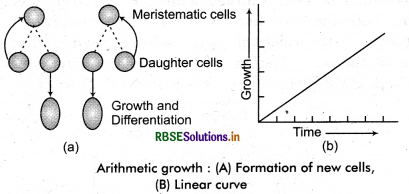
(b) Geometric growth:
The growth of a cell, an organ of plant or whole plant may not be same always i.e., it remains changing.
In initial stage the growth is slower, which is called initial lag phase. Later the growth is rapid at an exponential rate which is called middle logarithmic phase. After this the growth becomes slower, it is called last stationary phase. It is collectively called geometrical growth. Such growth can be seen by growing unicellular organism in a nutrient containing medium. It refers to the division of both daughter cells obtained during mitosis, i.e., here both the progeny cells following mitotic cell division retain the ability to divide and continue to do so.
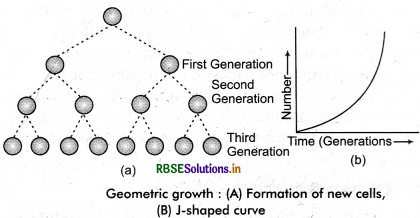
Geometric growth cannot be maintained for a longer period of time because some cells are dead and due to limited nutrient supply, the growth becomes slower leading to stationary phase. If we plot the parameter of growth against time, we get a typical sigmoid or S-shaped curve. Geometric growth can be represented in mathematical form of following:
W1 = W0ert
where, W1 = Final size (weight, height, number etc.)
W0 = initial size at the beginning of the period
r = growth rate
t = time of growth
e =base of usual logarithm
r is a relative growth, it is used for measurement of the capacity of formation of newly produced plant material by plant. If refers as efficiency index, thus final size of w1 depends upon initial size of w0.
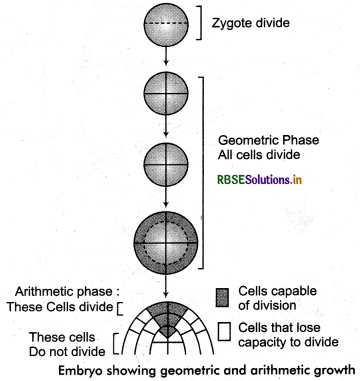
(c) Sigmoid growth curve:
Geometric growth can be divided into three phases:
(i) Initial lag phase
(ii) Middle log phase
(iii) Last stationary phase
If we plot the parameter of growth against time, we get a typical sigmoid curve which has S - shape. A sigmoid curve has following four steps:
1. Lag Phase: It represents initial stage of growth and has very slow growth rate. This period is comparable to the phase of cell division.
2. Log Phase: This phase exhibits very fast growth rate and comparable to the cell enlargement phase.
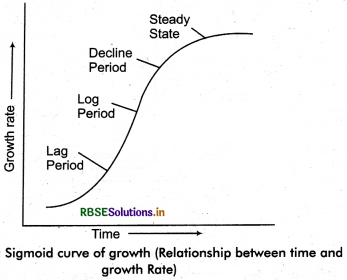
3. Decline Phase: In this phase the rate of growth declines once again. Slowing down metabolic activities results in decline period of growth.
4. Steady Phase: Growth almost complete and stops during this phase resulting in zero growth rate.
(d) Absolute and Relative Growth Rate:
(i) The measurement and the comparison of total growth per unit time is called the absolute growth rate (AGR).
(ii) The growth of the given system per unit time expressed on a common basis, e.g., per unit initial parameter is called the relative growth rate (RGR).
In given figure both of leaves are gained equal growth in then total area in a definite time period, though, the relative growth rate of leaf A is more.
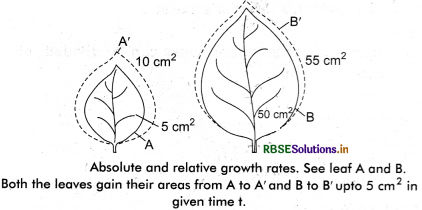
Question 4.
List five main groups of natural plant growth regulators. Write a note on discovery, physiological functions and agricultural/ horticultural applications of any one of them.
Answer:
There are five main groups of natural plant growth regulators. They are:
(1) Auxins
(2) Gibberellins
(3) Cytokinins
(4) Abscisic acid
(5) Ethylene
Auxins
A) Discovery of Auxin
In 1881, Charles Darwin and Francis Darwin performed experiments on coleoptiles of canary grass and observed that they bend towards the light, when exposed to light from a unidirectional source. They concluded that the tip of the coleoptile was responsible for sensing light, and proposed that a messenger is transmitted in a downward direction from the tip of the coleoptile, causing it to bend.
In 1913, Peter Boysen-Jensen concluded that the substance secreted at the tip is soluble in water (gelatin).
In 1928, F.W. Went showed that a chemical messenger diffuses from coleoptile tips and causes it to grow towards light. He later proposed that the messenger substance is a growth-promoting hormone, which he named auxin.
In 1931, Kogl and Haagen Smith isolated crystalline compounds from human urine and named them as auxin-a, auxin-b and heteroauxin.
B) Physiological functions of Auxins
Apical dominance
Control of abscission
Root formation in stem cuttings
Parthenocarpy
Differentiation of xylem and phloem
C) Agricultural/Horticultural Applications
Application of auxin promotes flowering in case of orchards.Examples: pineapple, litchi, etc.
Auxins also induce parthenocarpy in some plants like tomato, cucumber, pepper, etc.
Auxins like IAA, IBA, NAA induce rooting in stem cuttings of various plants.
Auxin like 2,4-D is widely used as a herbicide to kill dicotyledonous weeds and to prepare weed free lawns by gardeners.
Auxins regulate the maturation of fruits on trees of apples, oranges and grape fruit.

Question 5.
What do you understand by photoperiodism and vernalisation? Describe their significance.
Answer:
Photoperiodism: The duration of light (photoperiod) affects growth, flowering and proliferation of plants. The response of plants to period of daylight is termed as photoperiodism. In other words the functional responses of plants to changes of day and night is called photoperiodism.
The term photoperiodism is used first by Garner and Allard (1920). On the basis of photoperiodism, the plants are divided into following three groups:
- Short day plant (SDP)
- Long day plant (LDP)
- Day neutral plant (DNP).
Photoperiodism hypothesised that the hormonal substance responsible for flowering is formed in the leaves, subsequently migrating to the shoot apices and modifying them into flowering apices. Photoperiodism help in studying the response of flowering in various crop plants with respect to the duration of exposure to light.
Vernalisation: There are plants for which flowering is either quantitatively or qualitatively dependent on exposure to low temperature. This phenomenon is termed as vernalisation. This word first used by T.D. Lysenko in 1928. According to Chaurd (1960) gaining the ability to flowering in plants by chilling treatment is called vernalisation.
For most of the plants low temperature required for vernalisation ranges between 0 - 4°C. But it may be 0 - 20°C for some plants. Plants or seeds should not be exposed to high temperature (about 40°C) after chilling treatment, because it may lead to the loss of vernalisation effect. The loss of vernalisation is called devernalisation.
Question 6.
Why is abscisic acid also known as stress hormone?
Answer:
Abscisic acid stimulates the closure of stomata in the epidermis and increase the tolerance of plants to various kinds of stress. Therefore, it is also called the stress hormone. It promotes seed dormancy and ensures seed germination during favourable conditions. It helps seeds withstand desiccation. It also helps in inducing dormancy in plants at the end of the growing season and promotes abscission of leaves, fruits and flowers.
Question 7.
“Both growth and differentiation in higher plants are open”, comment.
Answer:
The higher plants retain the capacity for unlimited growth throughout their life. The ability of the plants due to the presence of meristems at certain locations in their body. The cells of such meristems have the capacity to divide and self - perpetuate. Therefore, growth in higher plants are open. Also, some of these cells always undergo differentiation after some rounds of cell division. Hence, the differentiation is also open.
Question 8.
‘Both, a short day plant and a long day plant can produce can flower simultaneously in a given place’, explain.
Answer:
Short day plants require comparatively short duration of light for flowering. In these plants the photoperiod must be less than certain critical period. When such plants are exposed to photoperiod greater than critical period they remain in vegetative phase and do not flower.
Long day plants require comparatively longer photoperiod for their flowering. In these plants the photoperiod must be greater than certain critical period. It is clear that the differentiation between SDP and LDP is made on the basis of flowering at short duration or long duration from critical photoperiod.
The plants of two different species flower in light of equal duration, but among them one may be LDP and other one SDP. For example the critical photoperiod of Xanthium is 15\(\frac{1}{2}\) hours, while Hyoscyamus niger has the 2 critical photoperiod of 11 hours. If both plants are kept in 14 hours light duration, they can flower. Accordingly Xanthium is SDP because it flowers in short photoperiod than critical photoperiod and Hyoscyamus niger is LDP, because it flowers in long photoperiod.
Question 9.
Which one of the plant growth regulators would you use if you are asked to:
(a) induce rooting in a twig.
(b) quickly ripen a fruit.
(c) delay leaf senescence.
(d) induce growth in axillary buds.
(e) ‘bolt’ a rosette plant.
(f) induce immediate stomatal closure in leaves.
Answer:
(a) Auxin
(b) Ethylene
(c) Cytokinin
(d) Cytokinin
(e) Gibberellins
(f) Abscisic acid.
Question 10.
Would a defoliated plant respond to photoperiodic cycle? Why?
Answer:
No, a defoliated plant will not respond to photoperiodic cycle as the leaves are the sites of perception of light/dark duration. Therefore, in the absence of leaves, the plant would not respond to light.
Question 11.
What would be expected to happen if:
(a) GA3 is applied to rice seedlings.
(b) Dividing cells stop differentiating.
(c) A rotten fruit gets mixed with unripe fruits.
(d) You forget to add cytokinin to the culture medium.
Answer:
(a) If GA3 is applied to rice seedling, then the rice seedlings will show internode elongation and increase in height.
(b) If dividing cells stop differentiating, then the plant organs such as leaves and stem will not be formed.
(c) If a rotten fruit gets mixed with unripe fruits, then the ethylene produced from the rotten fruits will hasten the ripening of the unripe fruits.
(d) If you forget to add cytokinin to the culture medium, then cell division, growth and differentiation will be slower.
